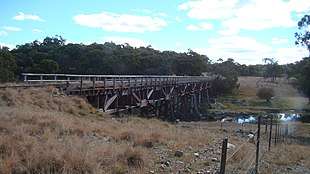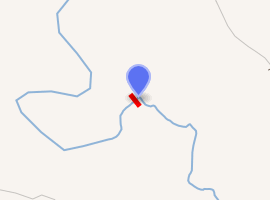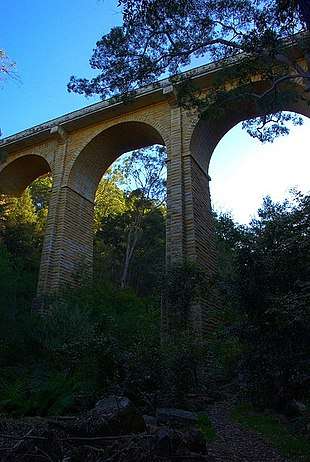Yarraford Rail Bridge over Beardy Waters
The Yarraford Rail Bridge is a heritage-listed closed railway bridge that carried the Main Northern line across Beardy Waters, situated 694.371 kilometres (431.462 mi) from Central station, near Glen Innes, in the Glen Innes Severn local government area of New South Wales, Australia. The bridge was designed by John Whitton in his capacity as Engineer-in-Chief for Railways and built in 1886. It is also known as Beardy River Railway Viaduct. The property is owned by RailCorp, an agency of the Government of New South Wales. It was added to the New South Wales State Heritage Register on 2 April 1999.[1]
Yarraford rail bridge | |
|---|---|
 The Yarraford rail bridge, in 2011 | |
 Location in New South Wales | |
| Coordinates | 29°38′16″S 151°46′51″E |
| Carries | Main Northern line |
| Crosses | Beardy Waters |
| Locale | Glen Innes, Glen Innes Severn, New South Wales, Australia |
| Other name(s) | Beardy River Railway Viaduct |
| Owner | RailCorp |
| Characteristics | |
| Design | Queen post truss |
| Material | Timber |
| Longest span | 12 metres (40 ft) |
| No. of spans | 9 |
| Rail characteristics | |
| Track gauge | 4 ft 8 1⁄2 in (1,435 mm) standard gauge |
| History | |
| Engineering design by | John Whitton |
| Construction start | 1884 |
| Construction end | 1886 |
| Official name |
|
| Type | State heritage (built) |
| Designated | 2 April 1999 |
| Reference no. | 01068 |
| Type | Railway Bridge/ Viaduct |
| Category | Transport - Rail |

| |
History
When John Whitton, Engineer-in-Chief for Railways 1856-1890, extended the Main North Railway from Muswellbrook to Glen Innes between 1870-1884 it climbed through the highest parts of the Great Dividing Range into the New England Region. Gradients were steep, curves were sharp, there was heavy earthworks and some major iron lattice bridges. It was expensive railway construction.[1]
When the section from Glen Innes to Tenterfield was planned, economies were made, particularly with bridges. They had to be timber, mostly ballast top timber beam bridges but at three locations larger bridges were required, over Beardy Waters, and the Severn River and Bluff River.[1]
Whitton, a successful railway engineer from England, chose the design of one of Isambard Kingdom Brunel's timber bridge viaducts built in Cornwall during the 1850s. The model chosen was the St Germans Viaduct composed of composite deck Queen post trusses, with the bottom chords being large iron rods. Whitton's staff redesigned the trusses to be all timber and the viaducts were built during construction of the Glen Innes to Tenterfield section 1884-86.[1]
The final section to Wallangarra (1888) was mostly easier over plateau country but the crossing of Tenterfield Creek required a large bridge and a timber Queen post truss viaduct was built there also, the fourth between Glen Innes and the Queensland border.[1]
Only two other such timber viaducts were built in this period, the Ingalara Creek railway bridge and the Bredbo River railway bridge on the Bombala railway line.[1]
Description
The bridge is a nine-span timber truss viaduct. Each span is 12 metres (40 ft), centre-to-centre, of timber trestles.[1]
The trusses are deck Queen post copied from one of Brunel's Cornish timber bridges (St Germans), built about 30 years earlier.[1]
The condition was assessed as fair as at 5 April 2006, having declined due to lack of maintenance since rail services were suspended. As with the other four viaducts on this section of line, it retains its original fabric.[1]
Heritage listing
Yarraford rail bridge over Beardy River was listed on the New South Wales State Heritage Register on 2 April 1999 having satisfied the following criteria.[1]
The place is important in demonstrating the course, or pattern, of cultural or natural history in New South Wales.
The timber Queen post truss viaduct was an economic bridge for the Glen Innes to Wallangarra Railway at a time when the boom years of the 1880s was ending and funding for railway construction was decreasing.[1]
The place is important in demonstrating aesthetic characteristics and/or a high degree of creative or technical achievement in New South Wales.
Despite a degree of inaccessibility, the timber viaducts over the Beardy, Severn and Bluff Rivers are impressive structures within their rural landscapes. At Tenterfield, the adjacent New England Highway provides easy viewing of the 4th such viaduct.[1]
The place has a strong or special association with a particular community or cultural group in New South Wales for social, cultural or spiritual reasons.
The Main North Railway made a significant contribution to the development of the New England Region from the time of its construction 1882-88, and the four timber viaducts were important items of the railway's infrastructure.[1]
The place has potential to yield information that will contribute to an understanding of the cultural or natural history of New South Wales.
The timber Queen post deck viaduct was a significant structure in place of the expensive iron lattice bridges preferred by John Whitton. The viaducts were technically sound and durable, having been built from renowned ironbark hardwood.[1]
The place possesses uncommon, rare or endangered aspects of the cultural or natural history of New South Wales.
These four viaducts and the two on the Cooma Line are the only ones of their type built. They are a unique class of railway bridge.[1]
See also
- List of railway bridges in New South Wales
References
- "Yarraford rail bridge over Beardy River". New South Wales State Heritage Register. Office of Environment and Heritage. H01068. Retrieved 2 June 2018.
Bibliography
- Rail Infrastructure Corporation (2003). Rail Infrastructure Corporation s.170 Register.
Attribution
![]()
External links
![]()
